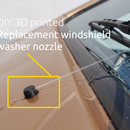Introduction: Inexpensive Gearmotors for Small Robots
Need small, powerful, and inexpensive motors for your newest small robot project?
I discovered these "N20" Gearmotors a year or so ago, while working on my ProtoBot project. They're tiny, powerful, and abundant from many sources online. You can get them in a range of voltages and RPM values, and for a few more dollars, with integrated hall-effect encoders.
Step 1: Supplies: Parts 'n Tools
When you're ready, here's what you'll need.
Parts:
- N20 Gear Motors - I use 12V 300RPM, for 150RPM at 6V. (Note: If you need different values than the ones in the listing, just search eBay for "N20 gear motor", followed by your specific values.)
- DuPont Female-to-Female jumper wires (40 wires per lot, 2 used per set of 2 motors)
Tools:
- Soldering Iron (This $7 iron is one I've used before, and I like them much better than any other iron I've used, besides my own fancy soldering station)
- Solder (Comes with the iron)
- Wire Cutters/Strippers
- Helping Hands, or something to hold the parts with - I use masking tape and foam, but helping hands would be easier in most cases
Total cost for 2 motors is $8.10, including shipping. If you shopped around a little more, say on AliExpress, I'm sure you could find them cheaper.
Note: Shipping on the eBay listings is from China, so it'll take about a month to get to you. If you need them by a certain date, order two months early if possible, to give the shipping plenty of time.
Step 2: Wires: Cut, Strip, Tin
Once you've forgotten about your parts, they'll show up on your doorstep and you'll be pleasantly surprised! Once you've gotten over it, here's what you need to do.
- For each 2 motors, separate 2 wires.
- Cut the wires in half (unless you want longer ones)
- Strip about 5MM or 1/4 inch of insulation off the ends
- Separate the ends a little, so each wire is separate, then twist the copper strands together so they don't get messy and stick out everywhere (They need to fit through the holes on the metal tabs on the motors)
- Tin each wire, by tinning your iron, holding the wire over your solder, then applying the iron.
Step 3: Networking
Haha! You thought you were safe, but little did you know I've tricked you into going to a networking conference! Eh, I'm kidding. "Soldering wires" just didn't sound snazzy enough.
- For each set of wires, bend the ends 180 degrees apart.
- Take a motor, and insert each wire end into one of the two holes in the two tabs.
- Secure the motors somehow. I used a piece of masking tape to hold a piece of foam down, then stuck the motors in that, shaft first.
- Solder the joint between the wires and the motor connection tabs.
Step 4: Reinforce Joints
Since I use these motors at camps where kids build little robots, the joint between the wire and the solder needs some method of reinforcement to keep them from breaking too easily. You don't have to do this, but it is a pain to remove old solder and wire bits from the tiny tabs on these motors.
- Use a hot glue gun to make a dab of glue around each joint, between the insulation ends and the connection tabs.
- If you hold the nozzle as close as possible and try to force the glue around the joint, it'll work better than just dabbing it onto the joint.
Step 5: Finished!
Congrats! You've now got yourself at least one little motor with easily connected wires attached.
These have a lot of torque, and they probably last ages too, with all metal gears. They'd be a great choice for anything where you want small motors without compromising quality, strength and durability. (Just be careful not to get hot glue in the gears. They don't like that.)
Need I tell you how to use them?
L293D motor driver chips are cheap and abundant on eBay, and they work great for 2 wheel drive robots, anything where you need to control two motors simple DC motors at once, or even for controlling a stepper motor. Information on using them with your favorite micro-controller is also abundant on the great wide web.




